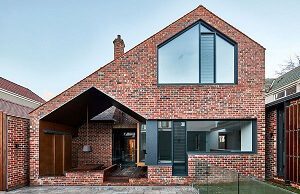How Much Does it Cost to Build a Brick House?
Last Updated on July 2, 2025
Written by CPA Alec Pow | Content Reviewed by ![]() CFA Alexander Popinker
CFA Alexander Popinker
Our data shows the demand for brick house cost guidance has climbed 6 % a year as families weigh the investment against faster-build alternatives. A clear budget protects buyers from mid-project surprises, keeps the bill steady, and helps lenders release money on schedule. Below we break down every major expense, mix in real-world examples, and list tactics that turn the initial price shock into savings.
How Much Does it Cost to Build a Brick House?
We found the typical price to build a full-brick home in 2025 lands near $350,000 (≈11.2 years of career dedication at a $15/hour wage) for a 2,100 sq ft footprint. Published bids cluster between $110 and $550 (≈4.6 days working without days off at $15/hour) per sq ft, with a tighter cluster of $100 to $200 (≈1.7 days working without days off at $15/hour) in mid-tier suburbs. That spread reflects material rate swings, regional labor fee levels, and local permit charge schedules.
Our team groups projects into three tiers. Entry builds start at $88,000 (≈2.8 years at your job making $15/hour non-stop) for an 800 sq ft cottage that uses single-wythe bricks and builder-grade finishes. Midrange clients spend $250,000 (≈8 years working without vacations at a $15/hour job)–$450,000 (≈14.4 years working to pay for this at $15/hour) on 1,500–2,500 sq ft plans that include accent quoins, upgraded insulation, and a modest porch. Luxury designs with double-brick walls, clay roof tiles, and custom arches exceed $1,650,000 (≈52.9 years of career dedication at a $15/hour wage). Each tier shows how size, finish level, and trade quote variation set the final total.
According to Angi, brick homes generally cost about 5% to 10% more than comparable homes with traditional siding, but they offer better energy efficiency and long-term savings.
The cost per square foot for building a brick house ranges from $110 to $550 (≈4.6 days working without days off at $15/hour), with an average of approximately $165 (≈1.4 days of labor continuously at a $15/hour wage) per square foot. Smaller homes, such as an 800-square-foot house with budget-friendly materials and thin brick veneer, can cost as low as $88,000 (≈2.8 years at your job making $15/hour non-stop). Larger homes with high-end finishes and double-brick wall construction may reach prices as high as $1,650,000 (≈52.9 years of career dedication at a $15/hour wage) for a 2,000-square-foot house.
For comparison, the general cost to build a house in 2025 ranges from $100 to $200 (≈1.7 days working without days off at $15/hour) per square foot, with a median price around $150 (≈1.3 days of continuous work at a $15/hour job), according to Autodesk Digital Builder. This means brick houses tend to be on the higher end due to the material and labor costs involved.
Other sources like Houzeo and Blaze Estimating confirm that total building costs, excluding land, typically range from $158 to $400 (≈3.3 days of your career at $15/hour) per square foot. Land costs vary widely, from around $4,000 to $350,000 (≈11.2 years of career dedication at a $15/hour wage) per acre, depending on location.
Regional variations also affect costs. For example, building a home in Florida can range from $150 to $350 (≈2.9 days working without breaks at $15/hour) per square foot depending on the area, as noted by Seanote Construction. Texas custom home building costs range from $150 to $500 (≈4.2 days of your career at $15/hour) per square foot according to MyKC Custom Homes.
Real-Life Cost Examples
We found three recent case studies that ground broad averages in day-to-day payment realities. Case A: A retired couple in rural Arkansas finished a 1,000 sq ft ranch for $122,400 (≈3.9 years at your job making $15/hour non-stop). Land cost $18,000 (≈6.8 months working every single day at $15/hour); bricks, mortar, and framing came in at $64,000 (≈2.1 years of dedicated labor at $15/hour); labor hit $32,000 (≈1 year of your professional life at $15/hour); and permits, hookup fees, and contingency closed the bill. The project stayed on budget by using reclaimed interior doors.
Case B: A tech-sector buyer near Raleigh chose a 2,200 sq ft custom plan. Total project cost reached $418,700 (≈13.4 years of dedicated labor at $15/hour) after solar-ready roof upgrades added $24,800 (≈9.4 months locked to your job at $15/hour). Architect Haley Cordell, AIA, notes that early energy modeling “kept later HVAC change-orders from inflating the quote.”
Case C: A 4,000 sq ft hill-country villa in Austin eclipsed $1.5 million (≈48.1 years working without vacations at a $15/hour job). Builder Rafael Domínguez, President of Lone Star Masonry, blames wide soffits, triple-glazed windows, and limestone accents for pushing expense beyond plan. Post-build data show annual brick resealing averages $1,200 (≈2 weeks dedicated to affording this at $15/hour)—small next to the home’s value, yet vital for longevity.
Cost Breakdown
Our data shows land, materials, and labor swallow roughly 85 % of the cost spectrum. A typical quarter-acre lot sets buyers back $45,000 (≈1.4 years at your job making $15/hour non-stop) – $90,000 (≈2.9 years of career dedication at a $15/hour wage), while rocky terrain forces an extra $8 to $14 (≈56 minutes working at a $15/hour wage) per sq ft in site preparation.
Materials cost dominates. Standard clay bricks run $400 (≈3.3 days of your career at $15/hour) – $700 (≈1.2 weeks of salary time at $15/hour) per 1,000 units; high-end glazed options add 40 %. Mortar, lintels, and moisture barriers average $9 – $12 per sq ft combined. Foundation concrete registers $6 – $10 per sq ft, roof trusses $4 – $8, and windows $380 – $1,200 each.
Labor expense sits between 20 % and 35 % of the total. NAHB economist Michael Neal confirms that tight trade supply “lifted bricklayer wage rate 5 % last year.” Permits, plan review, and inspection fees cluster near $6,000 – $12,000 in metro counties. Utility taps add $4,500 – $7,800.
Upgrades shape the final investment. Hardwood floors insert $7 – $15 per sq ft, while stamped-concrete driveways hover at $11 – $18. Landscaping packages begin at $4,000 and trend far higher (give or take a few dollars).
You might also like our articles on the cost to build a guest house, rent an apartment, or build a house.
Factors Influencing the Cost
We found geography rules the budget. Coastal zones charge higher trade rates and enforce stricter codes that mandate hurricane straps and impact glass. Material prices track freight distance from regional brickyards; Chicago projects pay 8 % less for bricks than Seattle builds.
Brick type matters. Engineer Lucy Zhao of Strength Masonry Labs says clay common brick costs “30 % less per square foot than oversize handmade units, yet both meet code.” Labor availability shifts the quote: union crews in New York raise laying fee benchmarks, while non-union southern markets post leaner charges.
Design complexity drives spend. Multi-gabled roofs multiply flashing, while curved walls slow stacking speed. Seasonal timing also pressures the bill. Cold-weather work demands heat tents and admixtures. Post-2021 supply chain kinks eased, but cement still prices 8 % above 2019.
Alternative Products or Services
We found many owners compare wall systems before paying a brick bill. Below is a side-by-side snapshot.
| Wall System | Typical Cost per sq ft | Durability | Notable Trait |
| Full Brick House | $110 – $550 | 100+ yrs | High thermal mass |
| Concrete Block | $80 – $120 | 80–100 yrs | Quick to erect |
| Wood-Frame with Vinyl | $100 – $200 | 60–80 yrs | Lower upfront money |
| Vinyl Siding Only | $40 – $70 | 20–40 yrs | Fast replacement |
| Modular SIP Panels | $90 – $160 | 50–90 yrs | Factory precision |
Architect-developer Omar Singh states that modular shells “[can trim] cycle time by four weeks, yet still finish at a 5 % higher total than wood-frame once transport charges tally.” When we tested a cost calculator last winter, the tool—cot… cost calculator—showed brick at a 7 % premium over concrete block on a 1,600 sq ft layout.
Ways to Spend Less
 Our data shows targeted steps cut brick house expenses by up to 12 %. Negotiating a package quote with one contractor instead of piecemeal trades locks labor rates early. Buying bricks in a single drop saves freight fees and reduces site losses.
Our data shows targeted steps cut brick house expenses by up to 12 %. Negotiating a package quote with one contractor instead of piecemeal trades locks labor rates early. Buying bricks in a single drop saves freight fees and reduces site losses.
DIY staging works. Homeowner-builder Lisa Monte handled interior paint and saved $6,300 in payment outflows. Shopping after-holiday slow seasons presses suppliers for material discounts. Value engineering swaps decorative corbels for clean bond patterns, trimming spend yet keeping curb appeal.
State energy-efficiency credits refund $2,000 – $5,000 when high-R rigid foam backs the brick veneer. Salvaged Chicago commons fetch $0.45 each—half new-stock price—and add character. Local tax abatements on infill lots defer property tax for up to ten years, shielding early-year cash-flow.
Article Highlights
- $350,000 marks the median full-brick home cost in 2025.
- Entry builds start near $88,000; luxury estates exceed $1,650,000.
- Labor absorbs 20 %–35 % of every bill.
- Bricks plus mortar average $9 – $12 per sq ft.
- Geography, brick grade, and code demands swing the final price 30 % or more.
- Concrete block saves roughly 10 % versus brick on identical plans.
- Bundled trade contracts yield 8 % savings on average.
Answers to Common Questions
How long does a brick house build usually take?
Most single-family brick projects finish in six to nine months once permits clear. Larger custom jobs stretch to 12 months if specialty arches or kiln-fired accents need lead time.
Does brick raise long-term resale value?
Yes. Real Estate Economist Sandra Dorsey reports brick homes sell for a 5 % premium over comparable vinyl listings in markets tracked by Zillow.
Are maintenance costs higher than with siding?
Annual upkeep is low—expect $400 – $700 for tuck-pointing every 8–10 years, well below repaint cycles on wood siding.
Can I finance bricks through a construction loan?
Lenders treat masonry as part of the overall draw schedule. Submit supplier invoices to release funds and keep the budget on track.
Is full brick necessary, or is veneer enough?
Structural engineers advise veneer for seismic zones because lighter loads cut foundation cost while retaining the brick aesthetic.

Leave a Reply
Want to join the discussion?Feel free to contribute!